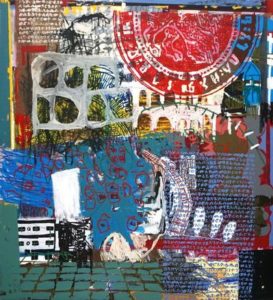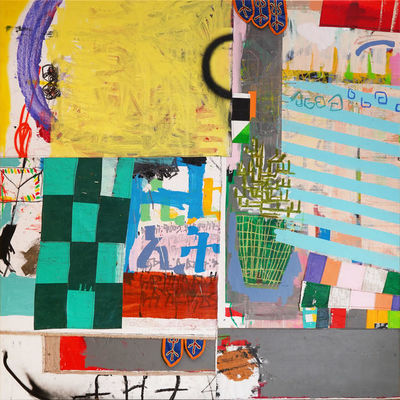
Wendimagegn Belete: Moment,
Until December 20 at Kristin Hjellegjerde Gallery London
About:
Stitching together fragments from historic and contemporary Ethiopian culture, Wendimagegn Belete creates vibrant, textural collage paintings that explore the concept of epigenetic inheritance, of memories that transfer over generations and permeate our present. For his latest solo exhibition, the artist presents a dynamic new body of work entitled አንዳፍታ (an Amharic word translated into English as ‘moment’) that fuses together artistic mediums, historic materials, and personal and collective experiences into a single throbbing pulse. Taking place at Kristin Hjellegjerde’s newest gallery space in Bermondsey, the exhibition also announces the official opening of Melior Place as the gallery’s main location.

Born in Ethiopia and based in Oslo, Belete’s practise is preoccupied with cultural heritage and identity. His process begins with the collection of source materials such as photographs from newspaper articles, letters, recorded conversations and various textiles – most significantly, traditional Ethiopian ceremonial garments, which the artist finds both aesthetically and symbolically interesting with regards to their continued presence in contemporary life. Fragments of these sources are then reassembled and stitched together to create a rich and complex visual landscape infused with the artist’s own personal memories and perspectives. Whilst varying in origin, most of the materials are in some way engaged with Ethiopia’s history, and more specifically, with Italy’s violent, albeit unsuccessful attempts to colonise the country. ‘Most of the time the colonial history has been narrated in a sad way, but I want to colourise it,’ says Belete.

One artwork, for example, contains the print of a photograph depicting two young boys, one of which is wearing a gas mask. The image, taken from an old newspaper, is in fact two kids training themselves how to use a gas mask in response to the frequent gas bombings by the invading Italian army. Removed from its original context and contrasted against a patchwork of bright colours, the image is made even more haunting, serving as a poignant reminder of the lasting impact of war, but also of the continuation of life despite conflicts of the past. Indeed, we might interpret the artist’s reshaping of these narratives through his art as an attempt to understand and actively reclaim history rather than letting it slip and fade from contemporary consciousness.
Art-making to Belete is partly a conscious construction of visual narratives and partly pure unconscious expression. ‘I believe that I possess memories from my ancestors and those are revealed to me when creating a work,’ he says. Whether or not you subscribe to this ideology, there is a palpable sense of urgency and spontaneity visible in the marks made by the artist’s hand. Each work is heavily layered not only with source materials, but also half-formed shapes, patterns and lines that appear dreamlike and abstract, interacting with the surrounding imagery to form a multitude of narrative possibilities.

It is this sense of possibility is what makes Belete’s work appear alive, and continuously evolving. To the artist, it is less about creating specifically focused series and more about forming a visual ‘memory map’ that transcends the boundaries of a single canvas. ‘I work on several paintings at one time, sometimes cutting a section from one painting and adding it to another,’ he explains. As such, the artworks are best viewed together, providing an immersive experience that conveys the intensity and energy of Ethiopian culture, just as Belete’s use of a distinctive colour palette works to convey a sense of the country’s climate, food and clothing. The varying shades of each artwork project varying moods through which we might filter the imagery, and perhaps find a clue to the artist’s own state of mind during the process of creation.
More significant, though, is the artist’s use of time, or rather disruption of conventional time structures. Refusing to distinguish between past, present and future visions, Belete instead attempts to portray a psychological and collective experience of time, which not only energises the past in the present moment, but encourages an accumulation of experiences as a way of making sense of history, culture and our place in the world as both community members and individuals.
